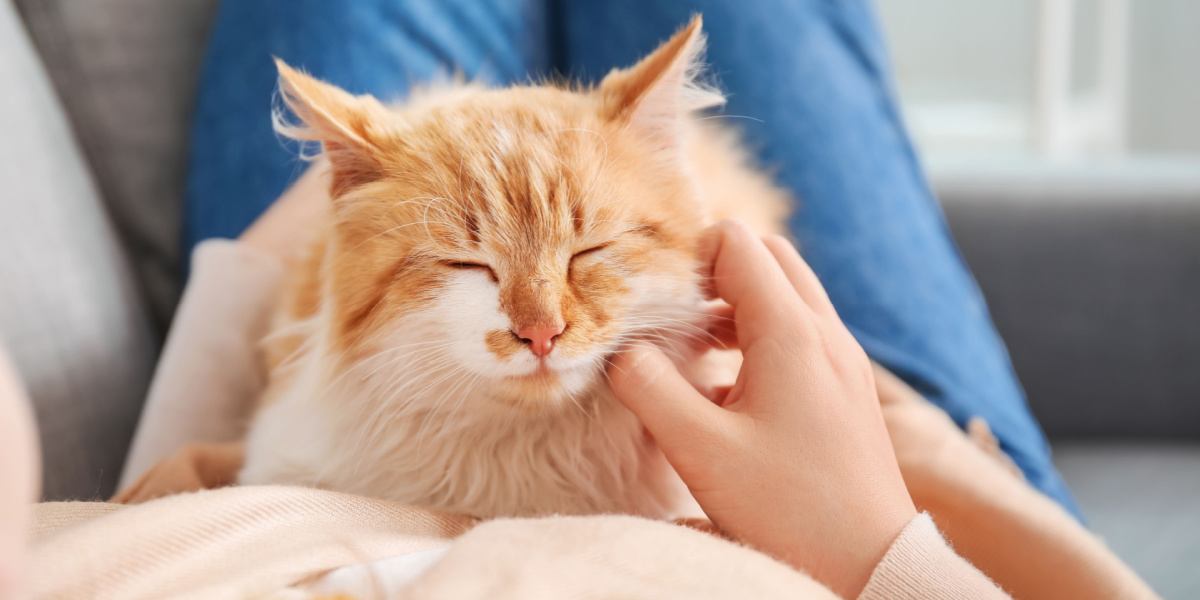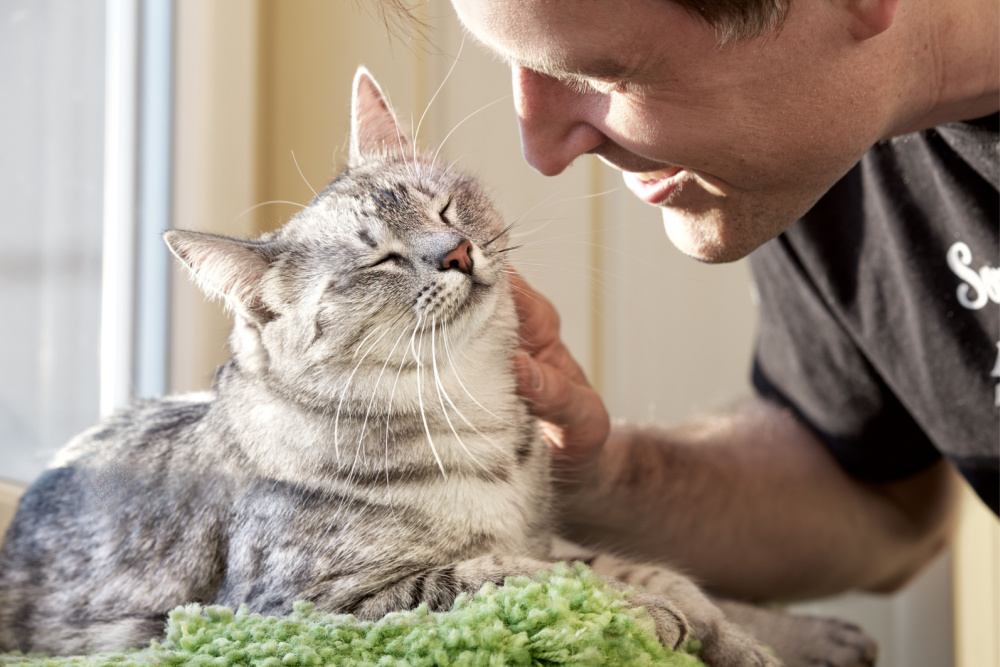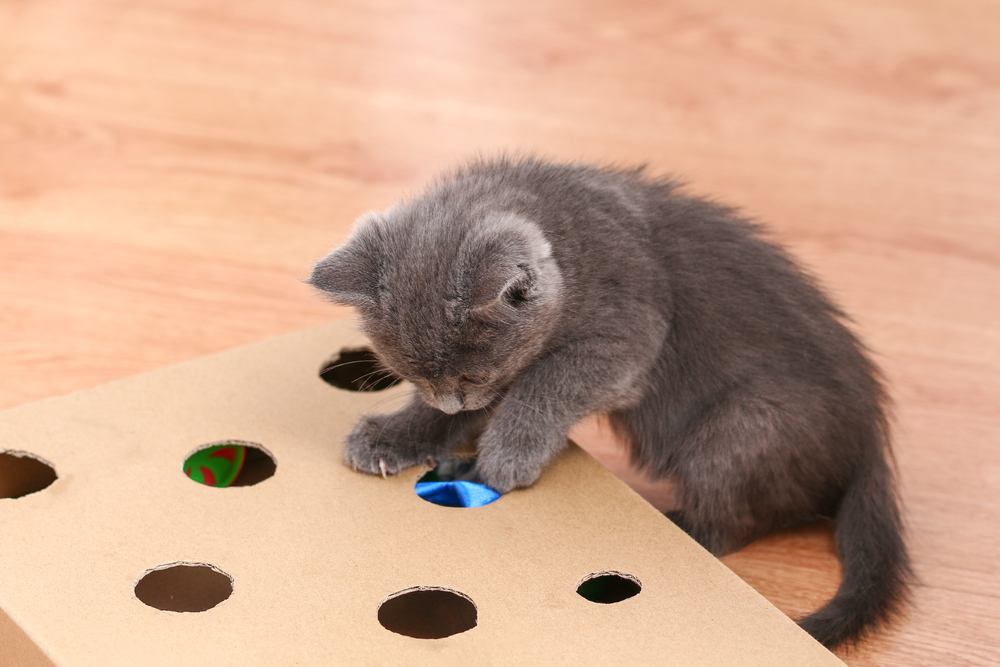
As a huge lover of all things feline, and a completely infatuated cat owner, I would just love to be able to talk to my cats! In fact, I often do hold one-sided conversations with my patient feline companions. Although they are excellent listeners, they have yet to answer me back.
Cats communicate in lots of different ways, such as through vocalizations, scent, cat body language, and visual cues. Learning about cat communication helps us understand our cats, and to get our messages across to them in return. Physical touch, scent, and eye contact are ways to directly communicate, but cat owners can also use indirect methods such as play and training.Key Takeaways
However, cats communicate in many complex and subtle ways. Paying attention to their behavior, body language, vocalizations and more helps us understand what our beloved pets are trying to tell us. In return, utilizing this knowledge also helps to show them our own thoughts and feelings.
Cat Communication
Cats can be a social species, and so have evolved many ways to communicate with each other. The ways cats interact are both varied and extensive. They include:
- Visual cues: tail positions and eye contact, for example
- Tactile communication: such as grooming and rubbing against each other
- Scent cues: including urinating and pheromone messages
- Vocalizations: chirping, purring, yowling, and more
Cats have adapted some of these methods to communicate with humans. They are adept at using body language and expressions and have been shown to recognize their owners’ emotions and respond appropriately.
There is therefore great potential for humans and cats to be able to communicate effectively, despite not being able to “talk” to them, as such.
How To Talk to Cats
Let’s look at some ways we can communicate with our cats.
1. Physical Communication
There’s nothing much better than a cuddle with someone we love, and this goes for our cats as well. Some cats are more physically affectionate than others, but communication doesn’t have to be all big lap snuggles or curling up on you to sleep. Other cats may prefer a loving head butt, a good kneading on your lap or affectionately twining around your legs when you return home after a trip out.
How To Talk Back:
If your cat rubs against you, kneads you, or gives you a cuddle, reciprocate in kind with some physical affection. If you’re unsure how a cat may respond to a stroke, start gently. Give them a scratch under the chin or a gentle stroke along the back. There are also other ways to physically bond for cats less keen on petting, such as a grooming session.
2. Eye Contact
Cats utilize visual signals in many ways, from pupil size to ear position, posture to tail height. A cat’s eyes can give you a good clue as to what they’re thinking and trying to tell you. Look out for the slow blink; this involves a few half-blinks followed by the closure or near closure of the eyes. In cat language, this slow eye movement is known as the “love blink” and is considered a key sign of affection.
How To Talk Back:
I love giving my cats the slow blink to let them know how much I love them. It’s a win-win for any cat person. Studies show that cats are more likely to approach you when given the slow blink sequence compared to a neutral expression, so you might gain some extra kitty cuddles by trying it out.
3. Vocalization

Feline body language and facial expressions, along with vocalizations, are some of the key ways that cats communicate.
Cats have a good range of sounds, from a meow to a purr, or a hiss to a yowl. We might not be able to speak cat, but we can certainly listen and understand. Knowing what certain vocalizations mean, and what context they’re used in, can help us respond appropriately.
For example, the trill or chirp is usually a friendly greeting, whereas the meow is most often used to ask for something, such as attention or food. Each cat is an individual, and learning to recognize your pet’s sounds is a very rewarding experience.
How To Talk Back:
I can’t master the funny little chirrup my cat gives me when I enter a room, but I do respond with a warm verbal greeting and a little head rub for her. Use calm, low tones around cats, as they have sensitive hearing. Recognizing warning sounds, such as hissing, and respecting the warnings, is also important when it comes to understanding your cat’s boundaries.
4. Training
Cats most certainly aren’t dogs, but did you know that they can be taught some simple commands and tricks? Cats respond well to positive reinforcement, such as treats and rewards to encourage certain behaviors. Training is a wonderful bonding experience for both cat and owner and can help with communicating needs.
For example, you could teach your cat to respond to their name, to use a litter box if not litter trained, or to come inside when called. Cats may not understand the words, but they can be taught to link a certain word or phrase to a behavior – effectively enabling you to talk to them.
How To Talk Back:
Using positive training methods, including clicker training, try some simple tasks with your cat. Even if you don’t manage any complicated tricks, it’ll be fun and help your communication.
5. Scent
We all want our cats to feel loved, confident, and safe. In inter-feline communication, cats use special scent chemicals called pheromones to leave messages for themselves and other cats. These messages convey a variety of meanings, but an important role is in territory marking, and communicating objects and areas as safe, comforting, and familiar.
How To Talk Back:
If your cat is having a stressful time, perhaps with a new cat, family member, or new routine, consider using a synthetic pheromone such as Feliway. These sprays or diffusers help cats feel more settled and reassured in their home environment.
6. Resources
It may seem basic to provide things like food, water, and litter boxes, but there’s more to these routine requirements than you might think. Cats tend to be particular about, well – everything. Multiple litter boxes should be available and placed in quiet, private areas, whereas scratching posts should be in high-traffic, visible parts of the home. Food and water bowls should not be placed too close together and arranged so that your cat doesn’t have to turn their back on the room to eat or drink.
How To Talk Back:
Working out what cats like and how you can arrange their resources to best suit them communicates to your cat how much you care for them. It may seem small, but making their environment comfortable sends a strong message of love and security to your cat.
7. Play

Playing with your cat is a wonderful way to build a bond and communicate.
Play is a wonderful bonding experience between cat and owner, and can help with multiple aspects of cat behavior. As well as physical exercise, it provides mental stimulation and an outlet for boredom, excess energy, innate hunting instincts, and athleticism. Invest in some cat toys, and set aside regular time to play.
How To Talk Back:
Think about whether your cat ever asks you to play. Do they ever bring you a toy? Or meow at you, swat at your moving hands or feet, or pounce on your toes? Pay attention to your cat’s play cues, and communicate back by initiating a play session with some appropriate toys.
Communication doesn’t always have to be through words. There are a whole host of ways that we can display our thoughts and feelings to our cats, and respond to their signals too. Paying attention to their cues, and clearly communicating ours in return, will lead to a more harmonious household, and stronger cat-owner bond.
Frequently Asked Questions
How do I communicate with my cat?
Pay attention to your cat’s vocalizations, body language and behavior to be able to learn what they like and to respond to them. Use physical affection, slow-blinking eye contact, familiar scents, and soft, warm speaking tones to convey to your cat how much you love them.
How do you say "hi" to a cat?
Cats often greet each other with a friendly chirp, an upright tail, and rubbing their heads together to share scents. Say "hi" to your cat by using a warm, friendly tone of voice and giving them a rub to their chin or head.
What do cats say when they talk to you?
Cat vocalizations can have different meanings. A trill or chirp is usually a greeting, whereas a meow is used to ask for something. Purring is most often due to contentment, whereas hissing and yowling convey fear, distress, or a warning.
-
Quaranta, A.; d’Ingeo, S.; Amoruso, R.; Siniscalchi, M. Emotion Recognition in Cats. Animals 2020, 10, 1107
-
Humphrey, T., Proops, L., Forman, J. et al. The role of cat eye narrowing movements in cat–human communication. Sci Rep 10, 16503 (2020)








My cat meows all night. He’s very interested in the cats outside. We have a lot of feral and stray cats. He’s fixed, and we got the strays TNR’d. We foster sometimes and he’s very friendly except for one time. Anyway,if he hears a meow outside he will meow loudly. He meows almost every night anyway. I wear earplugs to sleep. If I keep him in my room with me he is quiet but he and our other cat start playing so that doesn’t work. He is the sweetest, friendliest cat to us and other cats though. I just can’t get him to be quiet. Any advice? We are planning on moving soon to an apartment, and I’m afraid of the people complaining about him being loud. Honestly I think he wants all the outside cats let in and I can’t do that. My landlord would not be happy. 😂
Hi I have 4 cats and 3 of them are brothers but 2 of the brothers don’t get along I was wondering how can I get them to get along
I want to know too. I have 9 year old male ragdoll. Gorgeous, but, not interested in play ,cuddling or even pets. He does let me brush him. Also have 7 year old beautiful all white long hair little girl. I rescued her during covid. He’s always attacking her.
I loved learning about my cats from u your very smart my cats loved it when I did the love blink they did it back to cute I would like to learn more
It’s so sweet that you’ve already used some of these communication tools with your cat. Keep it up, and thank you for being here!